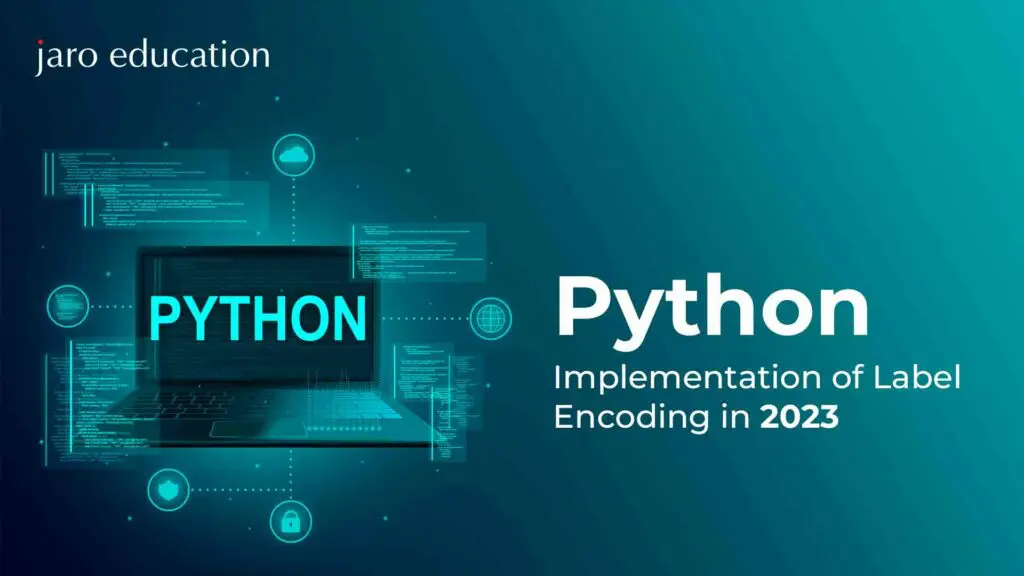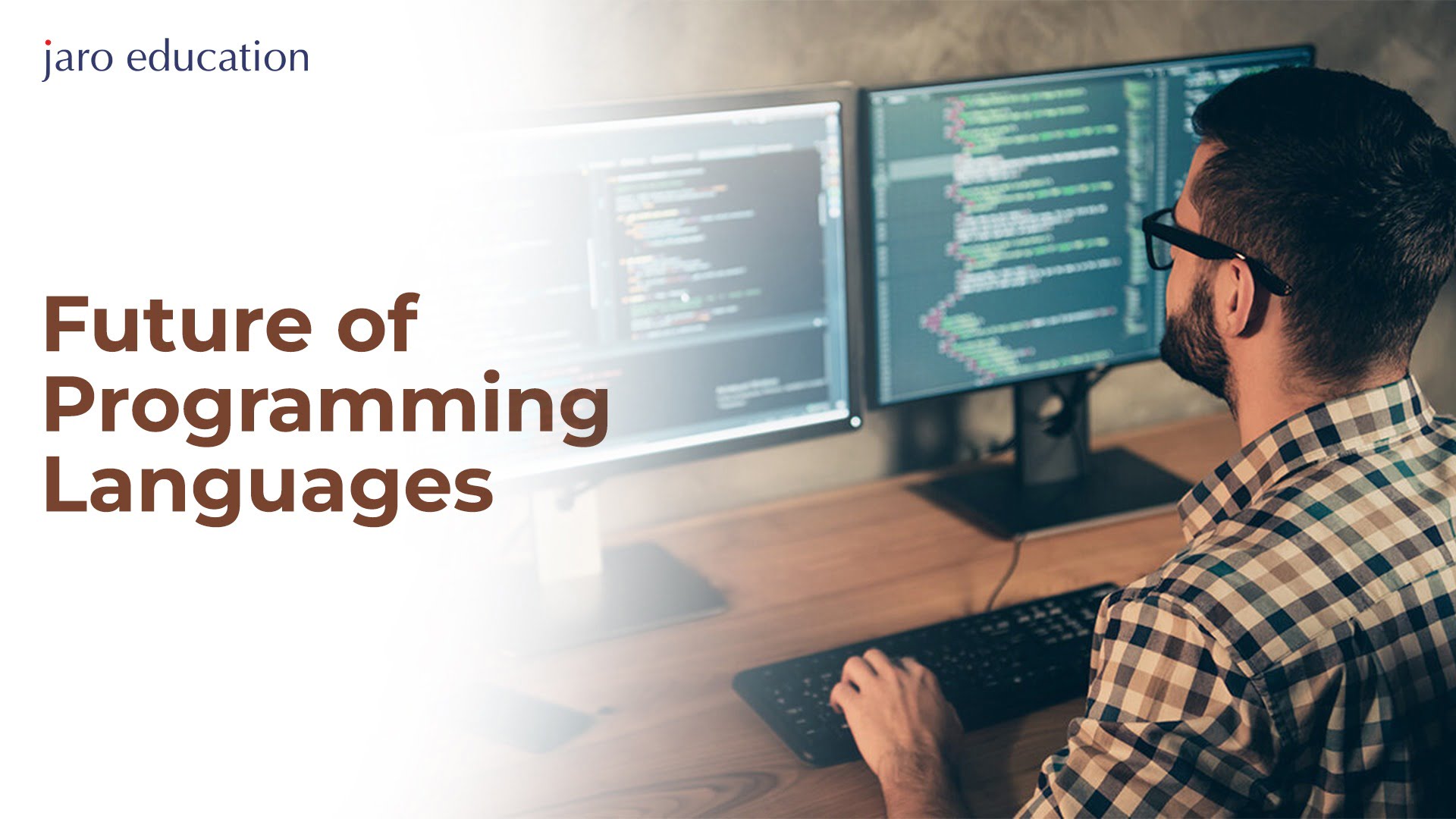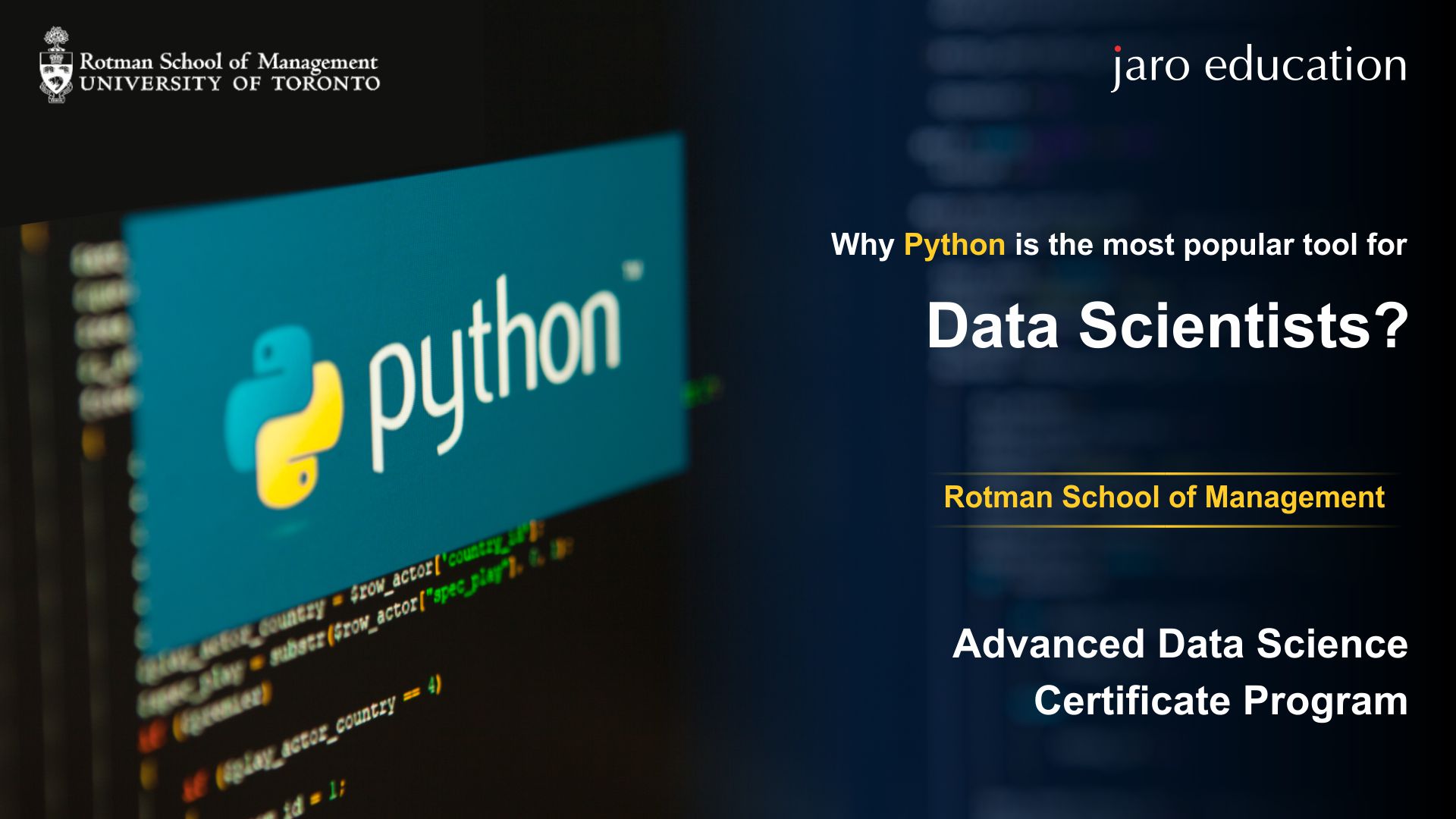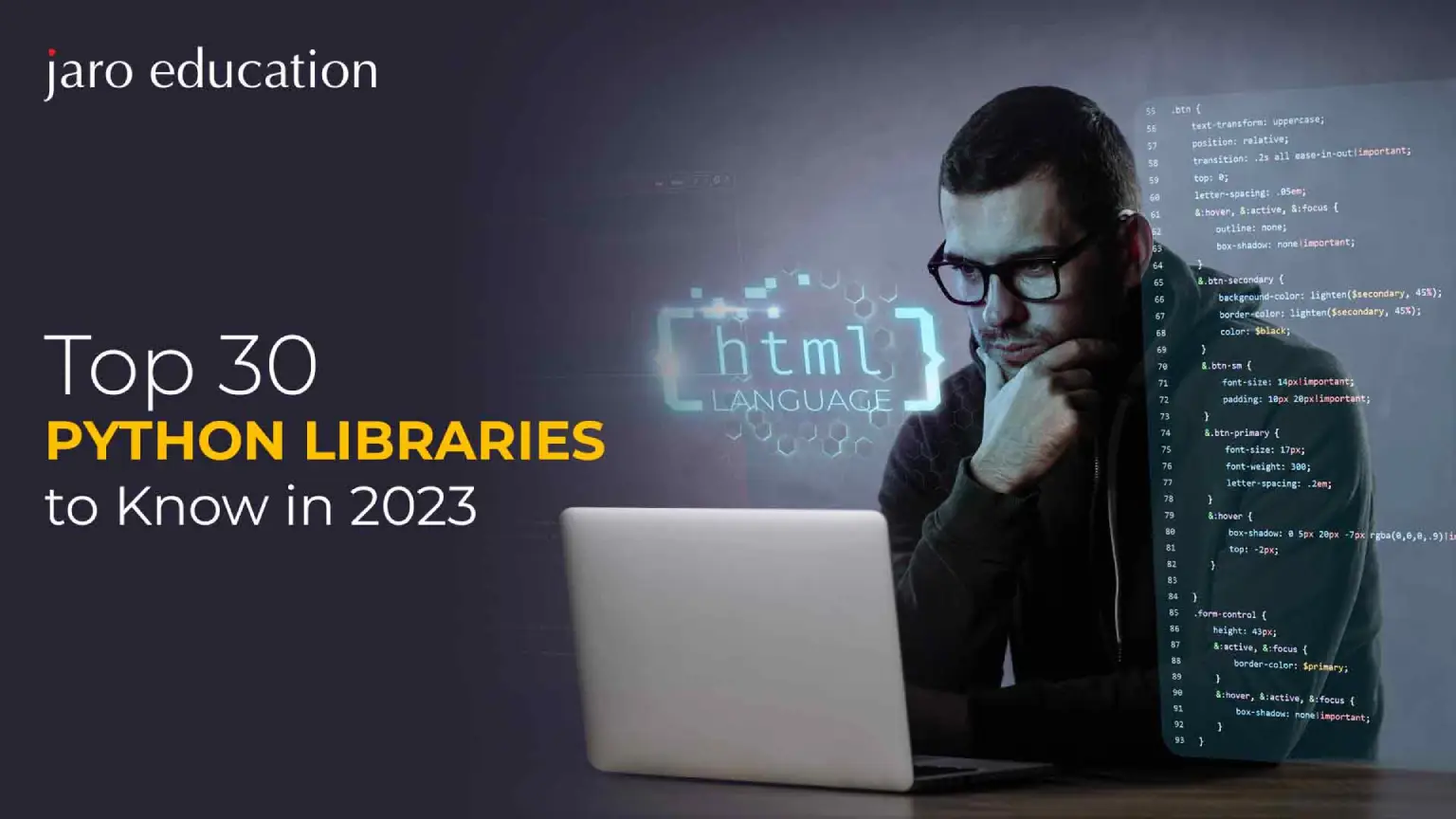
Python libraries are assemblies of already written codes that provide many functions and tools for a particular task. They are designed to import into Python programs, allowing users to utilise their skills without writing the codes from scratch. Python has a multifaceted system covering various domains, including scientific computing, manipulation, web development and machine learning. These libraries give reusable codes, which help simplify complex tasks that make Python a choice for various applications.
Pythons are evolving at lightning speed. Thus, enrolling in a certificate programme can help you stay updated with the current market. For instance, the Executive Programme in Applied Data Science using Machine Learning & Artificial Intelligence, offered by IIT Delhi. This 6-month programme provides an excellent opportunity for ambitious working professionals with a knack for advancing their careers in the world of Python with a highly interdisciplinary curriculum designed by industry veterans with years of experience. From cloud foundations to microservices, the syllabus covers all aspects of Python to prepare you to ascend in the field of AI and ML with ample knowledge and expertise.
Leading Python libraries:
The following are the Python libraries to be considered:
1. NumPy
Elaborated as numerical Python, NumPy is used for working with arrays. Travis Oliphant created this library in 2005, which can be used freely as an open source. Arrays are an essential function used in data science, where speed and resources are very important. It can be used in different domains of linear algebra, matrices, and Fourier transforms. In NumPy, the array object is known as ndarray, and it also has numerous supporting functions, which makes it easy to work with ndarray.
2. Pandas
In Python, one of the open-source libraries is Pandas which can be used in relational data effectively. It is also used in the manipulation of time series and numerical data. Pandas is a high-performance Python library. It is a fast and productive option for the users. This library is flexible and expressive, which makes relational or labelled data more accessible and intuitive. It aims to become the most powerful open-source library in the near future.
3. Matplotlib
In 2002, this library was introduced by John Hunter and was used for 2D plots of arrays and includes plots like line, bar, scatter, histogram, etc. It is built on a NumPy array and is designed to work on a broader SciPy stack. Almost all matplotlib utilised lie under the Pyplot submodule, and under plt alias, these are imported.
4. Seaborn
Seaborn is a Python library used for statistical graphics. It has beautiful colour pallets and graphics styles to make the statistical graphs attractive. It is constructed on top of the Matplotlib library and is integrated with Pandas. The data are easily explored and can be seamlessly understood under Seaborn. The plotting function consists of the entire dataset and performs the semantic mapping internally.
5. SciPy
This library is distributed under a BSD licence as it is an open-source scientific library used to solve mathematical algorithms and equations in Python. It is constructed on top of the NumPy library that gives an additional functionality of optimization, and integration to mathematical formulas like polynomial, matrix rank and inverse. If Scipy is imported, then there is no need to import the NumPy library.
Table of Contents
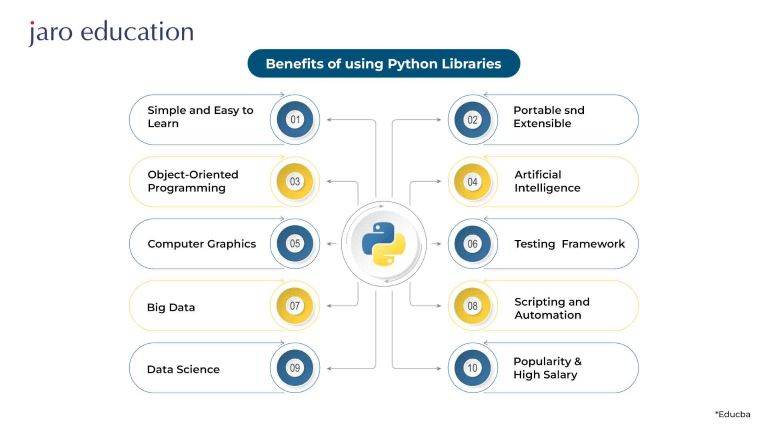
*Educba
6. Scikit-learn
This is also an open-source library that implements machine learning, the visualisation of algorithms, and cross-validation with the help of a unified interface. It is reusable in different contexts and is available to everybody. Scikit-learn serves as an essential tool for predictive data analysis, and it is commercially usable due to its BSD licence.
7.TensorFlow
It is a Python library used for artificial intelligence and machine learning. This Python library for AI is an end-to-end open-source library that can be used for numerous tasks, but its main focus is on the interface and training of deep neural networks. It was developed for internal Google use by the Google brain team. This is an open-source machine-learning library developed by Google, primarily used for building and training deep-learning models.
8. PyTorch
It was developed by Meta AIand as a part of the Linux Foundation and is based on the Torch library for machine learning framework. There are various deep learning software built on top of PyTorch, including Uber’s Pyro, Pytorch Lightning, and Catalyst.
9. Keras
This provides an easy way of creating deep learning models on Theno or TensorFlow. It runs on top of TensorFlow, an open source of machine libraries.
10. NLTK
Natural LanguageLtoolkit, popularly known as NLTK, is a platform used in building programs for Python along with human language data to apply in NLP( Natural language processing).
11. OpenCV
Machine learning, image processing and computer learning use an open-source library known as Open CV in Python, which plays a vital role in real-time operations. It is typically used to identify faces and objects by processing videos and images.
12. Requests
One of the most important parts of Python is a Request library used for HTTP requests in a particular URL. It is used in managing both the requests and the responses.
13. Beautifulsoup
There are mainly two ways of extracting data from a website. Firstly, if there exists an API, use it to extract data and, secondly, through HTML access. This technique of extracting data through HTML access is known as web scraping, and Beautifulsoup is a web scraping framework of Python used to extract data from web pages.
14. SQLAlchemy
In order to use a SQL database, the developers provide a toolkit of Python SQL to make it flexible to them. This helps the developers to use the language’s own object without writing the queries separately.
15. Flask
Developers can create lightweight web apps fast and easily with Flask because of the Flask web platform and Flask Libraries. Leader of the International Group of Python Enthusiasts (POCCO), Armin Ronacher, created it. Fundamentally, it is built on the WSGI toolkit and Jinja2 templating engine.
16. Django
Django is a high-level Python web framework that encourages efficient design and rapid development. It was designed by experienced developers to handle many of the complexities of web development, giving you the freedom to concentrate on creating your application rather than reusing tried-and-true methods. It is also known as a battery-included framework because of its built-in features like default database, SQLite3, and others.
17. FastAPI
A modern Python web framework for high-performance APIs is called FastAPI. It accelerates development, cuts down on errors, and offers intuitive code while guaranteeing speed on par with NodeJS and Go. It generates powerful, standards-based, and well-documented APIs with good editor assistance and little code duplication.
18. Pytest
Pytest is an effective Python testing tool that can be applied to all tiers and types of software testing. Development teams, QA teams, independent testing teams, TDD practitioners, and open-source projects can all use pytest. In reality, numerous websites, like Mozilla and Dropbox, have converted from unittest or nose to pytest. No other testing framework can compare to Pytest’s extensive capabilities, which include “assert” rewriting, a third-party plugin mechanism, and a robust yet user-friendly fixture model.
19. Pygame
Python modules called Pygame are created specifically for creating video games. On top of the excellent SDL library, Pygame adds capabilities. This enables them to write multimedia programmes and fully functional games in the Python language. Pygame may be used on almost any platform and operating system and is fairly portable.
20. Cython
Writing C extensions for Python is as simple with Cython as with Python. Pyrex is the foundation of Cython, which enables more modern features and optimizations. Python code may be converted to C/C++ code using Cython, allowing you to invoke C functions and declare C types on variables and class attributes. As a result, the compiler may convert Cython code into C code that is extremely efficient.
21. Folium
Folium is based on the Python ecosystem’s skills in data manipulation and the JavaScript library Leaflet.js’s strengths in mapping. Simply use Python to edit your data, then Folium to display it on a leaflet map. Data altered in Python can be easily viewed with Folium on an interactive Leaflet map. Several built-in tilesets from OpenStreetMap, Mapbox, etc., are available in this package.
22. Plotly
This is used for data visualisation and to understand it in an easy and clear manner. This is also used to plot different types of diagrams, including scatter diagrams, bar graphs, histograms, pie charts, and more. It is based on the JavaScript equivalent of Plotly (plotly.js), allowing Python users to produce dynamic visualisations for web applications. It features thorough documentation for chart creation, editing, and theming and effortlessly connects with Kaleido for picture export.
23. NetworkX
A Python-based software program called NetworkX is used to create, manipulate, and research complicated networks’ composition, dynamics, and operation. It is used to analyse enormously complicated networks represented as graphs with nodes and edges. Complex networks can be loaded and stored using this network. With this, one can create various random and conventional networks, examine network structure, create models, develop new techniques, and draw networks.
24. Gensim
This was introduced by Radim Rehurek to use in natural language processing and topic modelling. Semantic topics can be extracted from the documents and can also be used in handling large text. For many algorithms, Gensim also offers effective multicore implementations to speed up processing. Compared to other programmes like Scikit-learn, it offers more practical tools for text processing.
25. Bokeh
This is used in the creation of high-performance plots and charts. The output of this can be shown in various mediums like HTML, notebook, and server. Django and Flask apps can also be used to get the output. The main function of Bokeh is to transform the data source into a JSON file, which is then used as an input for the JavaScript library BokehJS and then written in TypeScript and hence, renders the visualisations in a browser.
26. Arrow
It is a logical and user-friendly method for producing, modifying, editing, and converting dates, times, and timestamps is provided by the Python package Arrow. It incorporates and updates the DateTime type, filling in functional holes and offering a clever module API that supports a wide range of typical creation scenarios.
27. Pygame zero
This is a simplified version of Pygame in order to develop games for educational purposes. It does not need to add all the boiler codes which are used in Pygame. It is a wrapper for the powerful PyGame package for creating video games in Python that is user-friendly for beginners and makes it incredibly simple to create a fun game with only a few lines of Python code.
28. FuzzyWuzzy
There are different ways in which strings can be compared in Python, but the easiest and most effective way of comparing strings is by FuzzyWuzzy, where the score is out of 100. FuzzyWuzzy module serves for matching strings. To calculate the variations among sequences, it uses Levenshtein Distance. SeatGeek has developed open-sourced FuzzyWuzzy.
29. PyPDF2
This is used to extract, merge, and separate PDF Files or to add watermarks to the files. With creating watermarks, PyPDF2 is also used in encrypting and decrypting PDF files. It is a pure Python module and can run on any platform. If someone intends to utilise PyPDF2 for the encryption and decryption of AES-encrypted PDFs, they must set up some additional requirements. RC4 encryption is accepted by the standard installation.
30. XlsyWriter
For creating files in XLSX file format, XlsyWriter is used extensively. In multiple worksheets, text, numbers and formulas can be used. It also supports formatting, conditional formatting, auto filters, charts, and images. It offers an excellent level of accuracy for Excel files. In most circumstances, the files created are exactly the same as those produced by Excel.
Takeaway
Python libraries, including NumPy, Pandas, Matplotlib, Seaborn and others, are helping developers to resort to various tasks in no time. These Python libraries help developers to design code without starting it from the very beginning. These Python libraries for AI and other operations can help you get answers to many tasks without the need for extensive coding.
To get a 360-degree understanding of Python language and libraries, enroll for the Executive Programme in Applied Data Science using Machine Learning & Artificial Intelligence by IIT Delhi through Jaro Education. From active live sessions to extensive doubt-clearing sessions on various topics in Python, this programme has got you covered. Register with Jaro Education to find out the details of this course, and look forward to a valuable professional course that can surely optimise your career growth.

